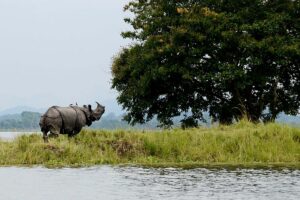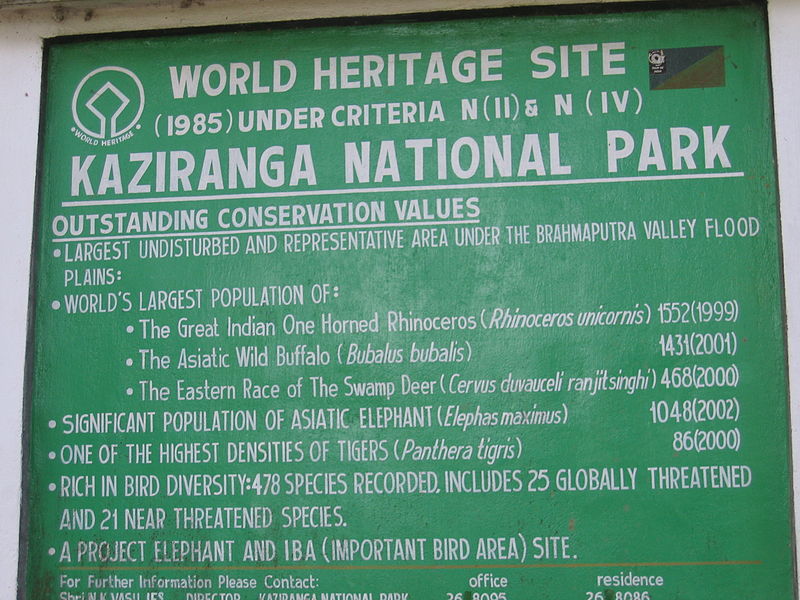The Golaghat and Nagaon districts of the state of Assam contain Kaziranga National Park. Anyone who believes that the Indian one-horned rhinoceros only lived during the Jurassic period ought to visit Kaziranga. With 430 square kilometres of elephant-grass meadows, swampy lagoons, and deep woods, Kaziranga National Park is one of the most popular wildlife vacation spots in India. It is also home to more than 2200 Indian one-horned rhinoceros, or almost 2/3 of the species’ global population. The park, which was established in 1908 on Mary Curzon’s advice, is situated on the outskirts of the Golaghat and Nagaon districts, two of the Eastern Himalaya’s biodiversity hotspots. The park was designated a World Heritage Site by UNESCO in 1985.
The wife of the Viceroy of India, Lord Curzon of Kedleston, Mary Curzon, reportedly visited the park but was unable to locate even one Indian one-horned rhinoceros. Then she convinced her husband to start making plans for their preservation in order to take immediate action to save the endangered species. In 1905, the 232 square kilometre Kaziranga Proposed Reserve Forest was established following a number of meetings and documentation.
Where is Kaziranga National Park located?
In the Indian state of Assam, there are three districts: the Kaliabor subdivision of Nagaon district, the Bokajan subdivision of Karbi Anglong district, and the Bokakhat subdivision of Golaghat district. Kaziranga is situated between latitudes 26°30′ N and 26°45′ N, and longitudes 93°08′ E to 93°36′ E.
The Kaziranga National Park is about 13 km wide from north to south and 40 km long from east to west. With a total area of 378 square kilometres, Kaziranga has recently lost 51.14 square kilometres to erosion. To provide additional habitat for increasing the population of wildlife or as a corridor for safe animal movement to Karbi Anglong Hills, a total of 429 square kilometre along the current Kaziranga National Park boundary has been made and designated with independent national park status.
The elevation varies from 40 to 80 metres. The Brahmaputra River, which defines the park’s northern and eastern boundaries, and the Mora Diphlu, which forms the southern boundary, encircle the area. The Diphlu and Mora Dhansiri are two additional notable rivers in the park. Flat areas of rich, alluvial soil can be found in Kaziranga thanks to the River Brahmaputra’s erosion and silt deposition.
The environment is made up of exposed sandbars, rivers that have created lakes called beels (which account for 5% of the surface area), and raised areas called chapories that serve as refuges and hives for animals during floods. To protect the safety of the animals, numerous artificial chapories have been constructed with the assistance of the Indian Army.
One of the largest protected areas in the sub-Himalayan region, Kaziranga has been dubbed a “biodiversity hotspot” due to the abundance of very diverse and visible species there. The Brahmaputra Valley semi-evergreen forests of the tropical and subtropical moist broadleaf forests biome, as well as the frequently flooded Terai-Duar savanna and grasslands of the tropical and subtropical grasslands, savannas, and shrublands biome, are the dominant ecoregions of the region, where the park is situated. The majority of the tea estates that surround Kaziranga significantly boost Assam’s economy.
History of Kaziranga National Park
When Mary Curzon, Baroness Curzon of Kedleston, the wife of the Viceroy of India, Lord Curzon of Kedleston, visited the region in 1904, Kaziranga’s history as a protected area began. She encouraged her husband to take immediate action to safeguard the endangered species after failing to sight even one rhinoceros, for which the area was famous. He achieved this by starting to arrange for their protection. The 232 square kilometre Kaziranga Proposed Reserve Forest was established on June 1st, 1905.
The Kaziranga National Park’s territory was increased by 152 sqaure kilometre during the course of the following three years, reaching the Brahmaputra River’s banks. Kaziranga received the designation “Reserve Forest” in 1908. Until 1938, when hunting was outlawed and people were allowed to access the park, it was renamed the “Kaziranga Game Sanctuary” in 1916. Kaziranga was renamed Kaziranha in 1934. P. D. Stracey, a forest conservator, renamed the Kaziranga Game Sanctuary the “Kaziranga Wildlife Sanctuary” in 1950 to remove any associations with hunting.
The Assam (Rhinoceros) Bill, which established severe penalties for rhino poaching, was passed by the Assam government in 1954. Kaziranga was established as a national park fourteen years later, in 1968, when the state legislature approved the Assam National Park Act of 1968. The central government granted the 430 square kilometre park official status on February 11th, 1974. Due to its distinctive natural setting, Kaziranga was named a World Heritage Site by UNESCO in 1985.
How Kaziranga got its Name?
Several myths, tales, and legends exist regarding the Kaziranga. According to one myth, a young man from Karbi Anglong named Kazi and a female from a nearby village named Rawnga fell in love. The pair went into the forest, never to be seen again, and the forest was named after them because their families did not approve of their relationship. Given that the Karbi language’s word Kazi means “goat” and Rangai means “red,” Kaziranga might possibly represent the “Land of crimson goats (Deer)”.
However, some historians contend that the Karbi phrase Kajir-a-rong, which means “the village of Kajir,” was the source of the name Kaziranga (kajiror gaon). Kajir is a typical Karbis girl child name, and it was formerly thought that a Kajir-named woman governed the region. This claim appears to be supported by fragments of Karbi-related monoliths that have been dispersed around the region.
Flora of Kaziranga National Park
This Kaziranga National Park has four main types of vegetation. These include tropical moist mixed deciduous woods, tropical semi-evergreen forests, tropical moist inundated grasslands, and tropical savanna woodlands. View of a barren tree in Kaziranga National Park taken from a watchtower with the background of distant meadows and a forest in the foreground.
The western side of the Kaziranga National Park is at a lower altitude than the eastern side, and there is a variation in altitude between them. Grasslands take up much of the park’s western sections. Short grasses cover the lower lands near the beels or flood-created ponds, while tall elephant grass grows on higher terrain. The reeds and grasses are maintained and fertilised through annual floods, herbivore grazing, and controlled burning. Sugarcanes, spear grass, elephant grass, and common reed are examples of common tall grasses. Along with the grasses, a lot of forbs are found. Scattered trees, such the elephant apple, cotton tree (found in savanna forests), Indian gooseberry, and kumbhi, provide cover and shade among the grasses.
Fauna of Kaziranga National Park

35 mammalian species with sizeable breeding populations may be found in Kaziranga, 15 of which are listed as vulnerable on the IUCN Red List. The park boasts the greatest populations of Greater One-Horned Rhinos (2,401), Wild Asiatic Water Buffalo (1,666), and Eastern Swamp Deer in the world (468). Large herbivores with significant numbers include Indian elephants (1,940), gaur (1300), and sambar (58). Wild boars, hog deer, and Indian muntjac are examples of small herbivores. With around 57% of the global population, Kaziranga has the highest concentration of wild water buffaloes. The “Big Five” of Kaziranga are the One-Horned rhinoceros, Royal Bengal Tiger, Asian elephant, wild water buffalo, and swamp deer.
For several kinds of big cats, including Bengal tigers and leopards, Kaziranga is one of the few places outside of Africa where they may reproduce naturally. According to the most recent census, Kaziranga has 118 tigers and the highest tiger density in the world (1 per 5 km2). It was designated a tiger reserve in 2006.
The leopard cat, fishing cat, and jungle cat are examples of other felids. The rare hispid hare, small Indian mongooses, huge Indian civets, Bengal foxes, golden jackals, sloth bears, Chinese pangolins, Indian pangolins, hog badgers, Chinese ferret badgers, and multicoloured flying squirrels are examples of small animals. The park is home to nine of the 14 primate species that may be found in India. The Assamese macaque, capped and golden langurs, as well as the solitary ape species in India, the hoolock gibbon, stand out among them. The endangered Ganges dolphin lives in the rivers of Kaziranga as well.
Best Time to Visit
Every year, from May 1 to October 31, Kaziranga National Park is off-limits to visitors. Therefore, the ideal season to explore Kaziranga National Park is from November to April.
Summer (April to May): During this season, the weather is still dry and windy, and wildlife can be seen around bodies of water.
Monsoon (June to September): From June through September, the area experiences 2,220 millimetres (87 in) of heavy rain, which keeps the environment hot and humid. Since there have been flood warnings for the Brahmaputra river, the park is closed from May to October.
Winter (November to February): Given the mild and dry weather, this may be the ideal time to explore Kaziranga National Park. As the grass burns off and the background becomes more visible in the winter, the chances of seeing rhinos increase.

